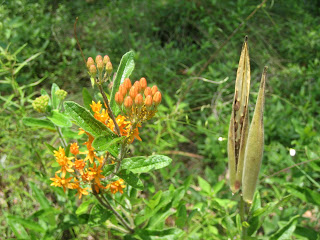Summer in the wildflower garden – some like it hot!
By Claudia Larsen
Although summer’s heat keeps many of us inside, it’s a busy time for wildflowers. Thousands of butterflies, bees, wasps and other insects visit flowers to obtain nectar. It’s also the changing of the guard, when lovely delicate spring bloomers such as Coralbean (Erythrina herbacea), Coreopsis and Skullcap (Scutellaria spp.) are replaced by sturdier heat-loving species.
Don’t forget to collect seeds from early-blooming wildflowers. These can be refrigerated in plastic bags and saved for fall planting. Or, simply sow them directly in other areas of your garden where they’ll naturally acclimate to temperature and rain patterns. Common wildflowers that seed in the summer include Coreopsis, Wild petunia (Ruellia caroliniensis), Stokes aster (Stokesia laevis), Blanketflower (Gaillardia pulchella), Dune sunflower (Helianthus debilis) and Salvia species.

Seeds develop and mature in an interesting variety of structures. Milkweed flower clusters form long cylindrical green pods. These contain brown seeds attached to a feathery white pappi that carry them on the breeze. This amazing adaptation is similar to the winged seeds of maple trees. I have also seen these soft white pieces entwined in birds’ nests – very comfy for the babies.
Now is also a good time to root cuttings of wildflowers with sturdy stems. Make 4- to 6-inch cuttings that have three nodes (where leaves attach). Remove leaves on the stems’ lower third and place the stems in a pot of wet dirt. Keep cuttings in shade and mist daily until rooted. Roots should form in three to six weeks. Be sure roots are large enough to support the plant before moving it into the garden. Plants that root easily include those in the mint family, such as Dotted horsemint (Monarda punctata), as well as Salvia species, Blue curls (Trichostema spp.), Wild petunia (Ruellia caroliniensis), Blue mistflower (Conoclinium coelestinum) and Twinflower (Dyschoriste spp.).
Claudia Larsen’s wildflower garden is in Micanopy, where she grows many North-Central Florida wildflowers.

